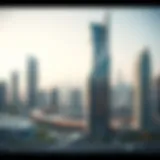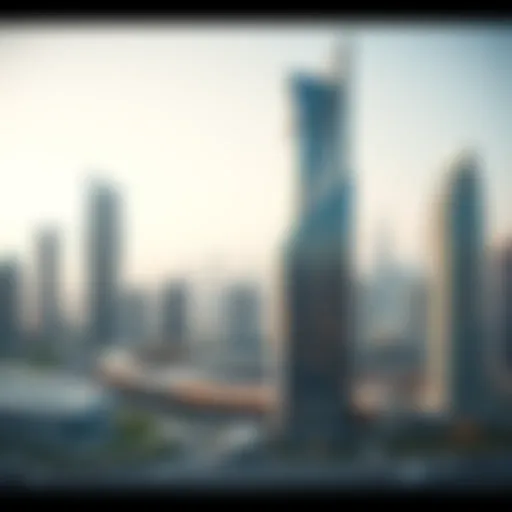Navigating the Dubai Metro: A Detailed Guide
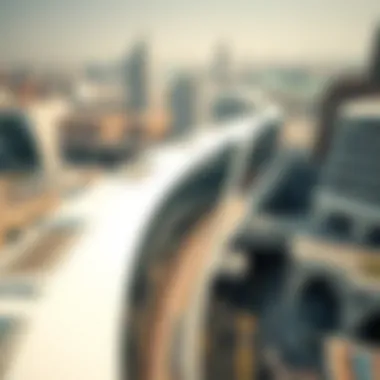

Intro
Delving into the nuances of Dubai Metro unveils an intricate web that binds urban transit, real estate dynamics, and economic growth. The Metro system, often regarded as the lifeblood of this bustling emirate, is not merely a mode of transport; it serves as a cornerstone of the city’s ambitious urban planning and economic foresight. By examining the evolution of the Metro, the operational features, and its intertwined relationship with surrounding neighborhoods, one gains a clearer picture of its significance in the greater transportation landscape. This exploration tackles essential aspects that are not only vital for the everyday commuter but consequential for investors and home buyers wanting to tap into the pulse of Dubai's real estate market.
As we navigate through this guide, we will spotlight how the Metro has influenced property trends, revealed investment opportunities, and shaped the urban fabric that makes Dubai a unique magnet on the world stage. Whether you are a seasoned investor or a first-time homebuyer, understanding these facets will equip you with the insights needed to make informed decisions in this fast-evolving market.
Prologue to Dubai Metro
In a city known for its towering skyscrapers and luxurious lifestyle, the Dubai Metro stands as a marvel of modern engineering and urban planning. This comprehensive guide delves into the intricacies of the Dubai Metro system, underscoring its significance not just as a mode of transportation, but as a catalyst for socioeconomic development within the emirate.
As the first urban metro network in the Gulf region, the system is a lifeline that connects various neighborhoods, making it an essential tool for commuters and travelers alike. Its impact goes beyond mere convenience; it reshapes the urban landscape, influencing real estate dynamics and contributing to Dubai's growing status as a global city. In short, understanding the Metro and its functions offers a unique lens into the rapid urbanization that characterizes Dubai today.
Historical Background
The journey of the Dubai Metro is astonishing, reflecting the emirate's vision for modernization that began in the late 20th century. Launched in 2009, this transportation marvel was conceived during a time when Dubai was experiencing an explosive population growth and economic diversification. Locals and expatriates alike were grappling with traffic congestion, prompting the government to explore efficient transportation alternatives.
The decision to construct the metro was heralded by the Road and Transport Authority (RTA), committed to curtailing traffic woes and making public transport a viable choice for residents. The ambition was to construct a fully automated metro system, and against all odds, Dubai delivered. The Red Line debuted in September 2009, covering extensive ground from Rashidiya to UAE Exchange, and soon after, the Green Line followed in 2011. These lines did not just alleviate traffic but also offered a glimpse into Dubai’s innovative spirit.
"Dubai Metro symbolizes the city’s commitment to sustainable urban transport—bringing forth the power of innovation and convenience."
Modern Features of the Metro
Today’s Dubai Metro is a union of cutting-edge technology and user-centric design. Equipped with driverless trains, the system operates through an intricate network of sensors and automated controls, ensuring safety and efficiency. The interiors boast modern amenities, with spacious carriages and digital displays providing real-time information about stops and schedules, making the commuting experience significantly smoother.
Accessibility remains a core focus—features such as designated spaces for people with disabilities and lifts connecting platforms to concourses enhance user experience.
In addition, the metro stations themselves aren’t just transit points; they are architectural feats adorned with unique designs. For instance, the Burjuman Station is a well-known hub due to its intricate geometric patterns, seamlessly blending form with function. Meanwhile, stations like Mall of the Emirates intersect the world of transportation with retail, hinting at the future where work, play, and travel coalesce.
With various fare options—ranging from NOL cards to monthly passes—the metro caters to diverse commuting needs, appealing to locals, tourists, and business travelers. This adaptability not only makes the metro system a pillar of community life but underpins the economic relevance of Dubai's transit infrastructure.
In summary, the Dubai Metro is a vector of change, reflecting the emirate’s dedication to fostering a modern and efficient urban environment while aligning with the broader ambitions of a city known for its forward-thinking initiatives.
Metro Lines Overview
The metro lines in Dubai serve as the backbone of the city's public transportation system. This section highlights why understanding the metro lines is crucial for anyone interested in navigating the city's expansive urban environment—especially investors, homebuyers, and urban planners. With the Dubai Metro being one of the most advanced in the world, its structure and efficiency hold key insights into the city's transportation dynamics.
- Connectivity and Accessibility: The metro lines provide seamless connectivity between various neighborhoods and commercial areas, effectively reducing travel time. This connectivity makes areas adjacent to metro stations attractive for real estate investments, creating a demand for properties close to these transit hubs.
- Economic Impact: Understanding the operational capacities of the metro lines can reveal how they influence economic activity. The Red and Green lines in particular not only enhance mobility but also stimulate local markets, making it essential for analysts and investors to gauge their impact.
Red Line Analysis
The Red Line of the Dubai Metro is arguably its most significant line, stretching from Rashidiya to UAE Exchange. This line covers 52 kilometers and has 29 stations. It plays a pivotal role in catering to both residents and tourists, making it a critical area for property investment.
- Key Stations: Starting from Rashidiya, the Red Line moves through essential stations like Burj Khalifa/Dubai Mall and the Dubai International Financial Centre, before ending at UAE Exchange. Each station is strategically located, serving high-density and high-traffic areas.
- Usage Statistics: The Red Line experiences heavy daily usage, with millions travelling across it every month. High commuter traffic boosts local businesses, making areas around stations ripe for investment.
"The Red Line acts as a lifeline for the city, binding together its commercial and cultural hotspots."
- Future Developments: There are plans for extending the Red Line further, which could significantly enhance real estate opportunities around new stations. Keeping an eye on such developments might prove beneficial for those looking to invest in future hot spots.
Green Line Exploration
In contrast to the Red Line, the Green Line spans 23 kilometers and connects key residential districts, thus making it indispensable for everyday commuters. It runs from Al Quoz to Etisalat, with 20 stations along the way.
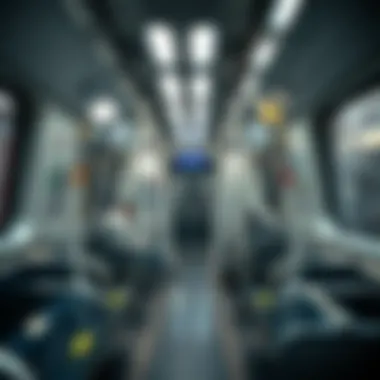

- Diverse Coverage: This line interlinks many of Dubai's older districts and newer residential areas, catering primarily to the local population. Stations like Al Jafiliya and Dubai Healthcare City serve vital commercial and healthcare hubs, which can influence property desirability.
- Market Influence: The Green Line complements the Red Line by providing access to less affluent but densely populated neighborhoods. Properties in these areas may not be as expensive as those near the Red Line, but they can offer solid returns due to consistent commuter traffic.
- Future Prospects: With the city continuously evolving, the Green Line could see extensions that service emerging neighborhoods, making it essential for buyers to monitor potential expansion plans in this area.
Station Profiles
Importance of Station Profiles
The station profiles of the Dubai Metro system offer a crucial lens through which to understand the overall impact of this metropolitan railway network. Each station serves more than just a transit point; it represents a node of connectivity that influences surrounding neighborhoods and impacts the lives of daily commuters. By examining specific stations, one can glean insight into the socio-economic dynamics at play—identifying where development is surging and which areas might need more attention. Moreover, understanding station profiles can be especially beneficial for investors and homebuyers, as proximity to major stations often correlates with property value and desirability.
Major Stations and Their Importance
Burj Khalifa/Dubai Mall Station
Located at the heart of the city, the Burj Khalifa/Dubai Mall station is among the busiest on the Red Line. It provides direct access to the iconic Burj Khalifa and the sprawling Dubai Mall, making it a hub not merely for transportation but also for tourism and retail. The economic activities spurred by this station should not be underestimated. The allure of such high-profile destinations adds considerable value to nearby real estate offerings.
Union Station
Union Station stands as a vital connecting point between the Red and Green lines. This strategic designation facilitates travel across the city, increasing its importance for residents and tourists alike. Plus, its proximity to Deira and Bur Dubai means it serves areas rich in history and culture. For stakeholders in the property market, the accessibility provided by this station enhances demand for nearby residential and commercial spaces.
User Experience
When it comes to public transport, User Experience can make or break a system. For the Dubai Metro, it is not just about getting from point A to B; it's about the entire journey, from purchasing a ticket to the final destination. For investors and homebuyers, understanding the user journey is crucial, as a well-functioning Metro system enhances property values and improves neighborhood dynamics.
Ticketing and Fares
The ticketing system of the Dubai Metro reflects a careful consideration for both residents and tourists. NOL cards are the lifeblood of this system and are designed for convenience. Users can purchase these cards at any station or online, ensuring accessibility at every level. The fare structure is straightforward, catering to different travel needs:
- Regular Tickets for casual users
- Monthly Passes for frequent commuters
- Visitor Tickets for tourists looking to explore the city
One crucial aspect to note is the pricing, which is based on zones. The more zones a traveler crosses, the higher the fare. This tiered system encourages use, while also generating critical revenue for maintaining the Metro. For many users, being able to tap in and out seamlessly with a simple card is a modern convenience that enhances satisfaction. With increasingly competitive fare rates, Dubai Metro provides an affordable transportation option, promoting a strong commuter base and, consequently, increasing real estate interest around station clusters.
Accessibility Features
The commitment to accessibility is a hallmark of the Dubai Metro. Wheelchair access, tactile guidance strips, and elevators at every station signify an effort to create an inclusive environment for all users. The stations are built with ramps and spacious hallways that accommodate not just those with physical disabilities but also parents with strollers or travelers with heavy luggage.
Moreover, the inclusion of signage in multiple languages further underscores the Metro's dedication to a diverse population.
"Accessibility isn't just about compliance; it's about enhancing the quality of life for everyone traveling in the city."
The introduction of special services, such as priority seating for the elderly and disabled, strengthens community bonds. Moreover, the importance cannot be overstated: for many potential buyers and investors, a well-connected Metro with robust accessibility indicates a future-forward approach that enhances property appeal in the nearby neighborhoods.
In summary, the user experience shapes how the Metro system integrates with Dubai's urban fabric. With user-friendly ticketing and comprehensive accessibility features, the Metro not only meets immediate transport needs but also enhances the overall quality of life in the emirate.
Metro's Role in Urban Development
The Dubai Metro is much more than just a transport network; it plays a vital role in the urban development of the city. Serving as a backbone for efficient movement, this system has become a critical element in shaping the emirate's urban landscape. Its integration into the city’s infrastructure has facilitated economic growth and enhanced the quality of life for residents and visitors alike. The following sections break down how the Metro influences both the real estate market and local neighborhood dynamics.
Impact on Dubai's Real Estate Market
The arrival of the Dubai Metro prompted a noteworthy shift in the real estate market. Properties situated near Metro stations have typically seen an increase in value, as the accessibility enhances their attractiveness. Potential homebuyers and investors are increasingly prioritizing locations near the Metro, leading to a competitive market around these key transit points.
Research indicates that areas within a 1-kilometer radius of Metro stations experience a surge in demand. This demand acts like a moth to a flame, drawing in both developers and residents attracted by the convenience and ease of commuting. Furthermore, properties located strategically next to stations, such as those along the Red Line, often command premium prices.
- Benefits to Investors:
- Considerations for Buyers:
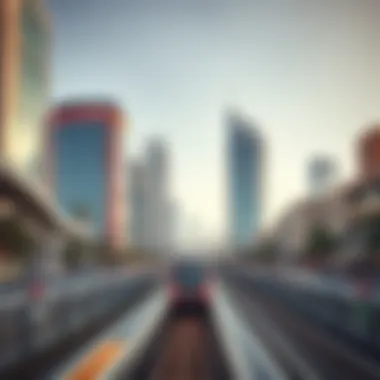

- Increased property values
- Higher rental yields
- Demand for short-term leases, especially among tourists
- Look for properties with potential appreciation due to proximity to stations
- Factor in the community and amenities available
In essence, the Metro acts as a significant catalyst in the real estate realm, directly affecting buyers' choices and investment strategies.
Catalyst for Neighborhood Growth
Neighborhoods surrounding Dubai Metro stations are undergoing critical transformations. The Metro not only improves transportation accessibility but also stimulates economic activities in these areas. Retail outlets, restaurants, and recreational spaces are springing up, creating vibrant local economies that cater to both residents and commuters.
Equally important is the social aspect — as areas become more accessible, community interaction increases, promoting a sense of belonging and engagement. This dynamic results in neighborhoods that don’t just house people but foster vibrant communities where individuals can thrive.
- Key Aspects of Growth:
- Increased foot traffic encourages local businesses to flourish
- Creation of public spaces for community events
- Opportunities for mixed-use development that combines living, working, and leisure spaces
"The Metro is more than a means of transport; it’s the pulse of urban expansion in Dubai, breathing life into underdeveloped areas."
In summary, the Dubai Metro system influences urban development by shaping real estate dynamics and fostering neighborhood growth; the result is a more connected, accessible city that continues to evolve while meeting the needs of its residents. By understanding these nuances, investors and homebuyers can make informed decisions that align with the growth trajectories of Dubai's diverse neighborhoods.
Sustainability and Future Trends
The importance of sustainability in urban transportation systems cannot be overstated. As cities worldwide grapple with rising populations and environmental concerns, adopting eco-friendly practices becomes paramount. The Dubai Metro exemplifies how a city can innovate its public transport to meet these challenges head-on.
Environmental Considerations
When we talk about the Dubai Metro and its environmental considerations, it's essential to recognize its role as one of the most advanced and eco-friendly metro systems globally. The construction and operation phases are designed with sustainability in mind. For example, the use of energy-efficient trains not only reduces energy consumption but also lowers carbon emissions. Additionally, stations incorporate sunlight into their designs, utilizing solar power to support various functions.
Key factors in the metro's environmental considerations include:
- Energy Efficiency: Trains that can regenerate energy during braking, sending it back to the grid.
- Smart Technology: Integration of smart technologies for energy management systems that optimize energy consumption.
- Recycling Initiatives: Adoption of comprehensive recycling practices at stations, including bin schemes for bottles and paper.
TheDubai Metro reduces reliance on fossil fuels and promotes a shift towards greener transportation. This is particularly relevant for a city that has historically depended on cars and taxis. By providing a clean alternative, it not only helps in reducing traffic congestion but also plays a part in making Dubai’s air cleaner.
Future Expansion Plans
The future expansion plans for the Dubai Metro unveil an ambitious vision entailing greater connectivity and service enhancements. As the urban landscape evolves, so do transportation needs. Plans for extending metro lines demonstrate an understanding of this rapid growth. The additions aim to reach underserved areas, tapping into neighborhoods not connected by existing infrastructure.
In detail, the expansion plans include:
- New Lines: Developing additional metro lines, such as the Purple Line, to connect new residential areas and commercial hubs.
- Increased Capacity: Upgrading current lines to accommodate more passengers, ensuring that the system can keep up with burgeoning user numbers.
- Integration with Other Transport: Connecting the metro with bus and tram systems to facilitate seamless travel throughout the city.
The ambition is clear: to position the Dubai Metro as not only a transportation solution but a pillar of sustainable urban development.
The foresight encapsulated in these expansion plans will certainly attract investors looking for stable growth opportunities. Property buyers should also take note, as proximity to metro stations generally leads to increased property values in the vicinity, reinforcing the economic relevance of these future projects.
Comparative Analysis with Global Metros
The comparative analysis of the Dubai Metro with other major urban transit systems is crucial for understanding its unique standing in the global context. This perspective not only highlights the operational efficiencies and design intricacies of Dubai's Metro but also draws connections to the lessons learned from other metropolitan networks. Such an analysis serves multiple purposes: it offers insights into best practices, identifies areas for improvement, and underscores the significance of transportation systems in urban development.
Dubai Metro vs. Other Major Cities


When put side by side with other prominent metro systems like Tokyo, London, or New York, the Dubai Metro presents an interesting case. It often stands out due to its driverless technology, which enhances safety and operational efficiency. Moreover, the overall cleanliness and modernity of the facilities give Dubai an edge in attracting tourists.
For instance, unlike the extensive underground networks of London or the sprawling, intricate paths of Tokyo, the Dubai Metro operates with a unique elevated rail system that offers panoramic views of the city's skyline. It provides not only convenience but also an experience that is both functional and visually stimulating. Furthermore, Dubai’s emphasis on customer service, seen in the design of spacious cars and amenities like Wi-Fi, sets it apart.
Key comparisons include:
- Operational Efficiency: Dubai Metro is noted for high punctuality rates, often exceeding 99%. In comparison, systems in New York face struggles with delays that can frustrate commuters.
- Accessibility and Convenience: The Dubai Metro is strategically planned to link major business and residential areas, reflecting careful urban planning practices that some other cities have yet to implement fully.
- Innovative Technology: The emphasis on technology innovation, such as the use of contactless payment systems and real-time tracking apps, showcases an understanding of modern commuter needs that several established systems still lag behind in.
"Dubai Metro is not just a transport system; it’s a commitment to redefining urban mobility in a rapidly growing city."
Lessons Learned from Global Practices
Analyzing global metro systems reveals several actionable insights for the Dubai Metro and other similar infrastructures. Lessons in flexibility, technological advancements, and public engagement emerge prominently:
- Flexibility and Adaptability: Cities like Singapore have adapted their systems to combat peak hour overcrowding by implementing flexible schedules. Dubai Metro could consider this to enhance user experience during rush hours.
- Community Engagement: Successful metro systems often engage with their communities as seen in Berlin’s outreach efforts that encourage public feedback on service improvement. Here, integrating public input could bolster the Dubai Metro’s efforts to remain relevant to its diverse user base.
- Sustainability Practices: Cities renowned for eco-friendly metro systems, such as Copenhagen, provide valuable lessons in reducing carbon footprints through green energy sources. Dubai could take steps to incorporate solar or wind energy into its operations, setting a standard for sustainability in desert climates.
Challenges and Critique
The Metro system in Dubai, despite its numerous accolades and success stories, faces its fair share of challenges. Analyzing these issues provides a well-rounded understanding of the system's operational dynamics and public sentiment. Assessment of challenges is crucial for anyone—whether an investor, homebuyer, or urban planner—looking to grasp the complete picture of Dubai's transportation landscape and its influence on real estate.
Operational Challenges
Dubai Metro operates in an environment that demands efficiency and adaptability. However, operational challenges abound. One primary concern is the maintenance of infrastructure. Given the harsh desert climate, startup maintenance costs can skyrocket while unexpected service interruptions may annoy commuters. It's vital for investors to know that ongoing maintenance affects both service reliability and public perception.
Another prominent operational hurdle is capacity management. During peak hours, trains can become overcrowded, leading to uncomfortable experiences for passengers. This can deter potential users from relying solely on the Metro for their commuting needs, which ultimately could impact its market position.
Additionally, the integration of new technology often presents a mixed bag. While advanced ticketing systems and digital information displays enhance passenger experience, they sometimes lead to technical glitches. Complications from such technical issues might tarnish the Metro's image as a cutting-edge transit system.
In summary, managing day-to-day operations while addressing these emerging challenges defines how Dubai Metro sustains its reputation and serves the community. Understanding these operational difficulties—ranging from maintenance to capacity—can offer potential stakeholders critical insights into their investment strategies.
Public Perception and Satisfaction
Public perception plays a significant role in the success of any transport system, and Dubai Metro is no exception. Generally, feedback from users highlights an overall positive sentiment. However, it's essential to delve deeper into specific aspects of passenger satisfaction.
On the positive side, many riders commend the cleanliness and punctuality of the Metro. The stations and trains exhibit a high standard of hygiene, translating to a comfortable commuting environment. Additionally, the connectivity offered by the Metro system is often praised, effectively linking major commercial and residential hubs.
However, it’s not all sunshine and rainbows. Some commuters express frustration regarding the fare structure. Even though ticket prices remain competitive compared to private transportation options, some users believe that the costs can add up quickly, especially for regular commuters.
Another element impacting public perception is the perceived safety. Instances of petty crime—while relatively low—can create a sensation of concern among users. A few safety measures, such as more visible staff presence during rush hours or increased surveillance, could significantly improve commuter confidence.
In the end, understanding public opinion is invaluable for those looking to invest in properties near Metro stations. It not only helps gauge the immediate demand for properties but also signifies the long-term viability of investments based on commuter preferences and sentiments.
Ending
The examination of the Dubai Metro system reveals its paramount significance in enhancing urban mobility and shaping the emirate's socio-economic landscape. As a backbone of public transportation, it not only provides efficiency in commuting but also influences real estate dynamics and urban development.
Summary of Findings
In summary, the exploration of the Dubai Metro covers multiple facets:
- Historical Context: The evolution of the Metro paints a picture of ambition and innovation, demonstrating Dubai's commitment to modernity.
- Operational Features: Enhancements such as automated systems and safety protocols underscore a liberal application of technology aimed at providing top-tier service.
- Regional Development: The Metro's impact on real estate is significant, drawing interest in neighborhoods and fostering growth.
- Sustainability Initiatives: Measures undertaken aim to integrate eco-friendly practices into transport solutions, reinforcing Dubai's message of focusing on sustainability.
- Challenges Encountered: Despite its successes, operational hitches and public perception issues sometimes dampen the user experience, a detail that's not to be overlooked.
Implications for Investors and Buyers
Dubai's Metro system holds vast implications for those eyeing real estate investments or property acquisitions. For investors, understanding the correlation between Metro stations and property values can guide sound decisions. Proximity to a Metro station often enhances property attractiveness, leading to potential value appreciation.
Moreover, the continual expansion of the Metro network can signal growth areas for future real estate developments. Properties along strategic locations on Metro lines promise returns while providing residents a gateway to ease of transport—crucial in a bustling city like Dubai.
In essence, grasping the intricacies of Dubai's Metro not only arms investors with the know-how to make informed choices; it simultaneously illustrates how integral public transport can be in urban planning and development. This understanding may very well tip the scales in favor of those willing to engage with the market at this pivotal juncture.






